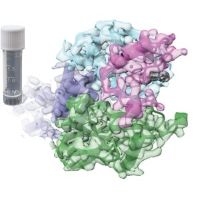Specification
| Organism | Mus musculus (Mouse) |
| Expression Host | E.coli |
| Tag Info | N-terminal 10xHis-tagged and C-terminal Myc-tagged |
| Purity | Greater than 85% by SDS-PAGE |
| Uniprot ID | Q8R507 |
| Gene Names | Fktn |
| Alternative Names | Fukuyama-type congenital muscular dystrophy protein Ribitol-5-phosphate transferase |
| Expression Region | Partial(29-461aa ) |
| Molecular Weight | 57.8 kDa |
| Protein Sequence | KHYLSARNGPGSSKSKGNRVGFDSTQWRAVKKFIMLTSSQNVPVFLIDPWILESINKNFEQVKNASQGPASECRFFCVPRDFTAFALQYHLWKNEDGWFRIAENMGFQCLKTESKDPRLDGIDSLSGTEIPLHYVCKLTTHAIHLVVFHERSGNYLWHGHLRLKGHMDRKFVPFRKLQFGRYPGAFDRPELQQVTVDGLDMLIPKDPGRFLEEVPHSRFIECRYKEARAFLQQYIDDNTVDAMVFRKRAKELLQLAAKTLKDLGVPFWLSSGTCLGWYRQCGIIPYSKDVDLGIFIQDYKPDIILAFQEAGLPLKHKFGKVEDSLELSFQGKNDVKLDIFFFYEEADHLWNGGTQARTGKKFKYLFPKFTLCWTEFVDIKVHVPCETVDYIEANYGKTWKIPIKTWDWKSSPPNVQPNGIWPISEWDEVIQLY |
| Form | Liquid or Lyophilization |
| Buffer | The default storage buffer is Tris/PBS-based buffer, 5%-50% glycerol if the delivery form is liquid. The lyophilization buffer is Tris/PBS-based buffer, 6% Trehalose, pH 8.0 if the delivery form is lyophilized powder. Please contact us if you have any special requirment. |
| Reconstitution | Please reconstitute protein in deionized sterile water and we recommend that briefly centrifuge thevial prior to opening the vial .We recommend aliquot for long-term storage at -20℃/-80℃. |
Background
| Relevance | Catalyzes the transfer of CDP-ribitol to the distal N-acetylgalactosamine of the phosphorylated O-mannosyl trisaccharide (N-acetylgalactosamine-beta-3-N-acetylglucosamine-beta-4-(phosphate-6-)mannose), a carbohydrate structure present in alpha-dystroglycan (DAG1) (PubMed:12471058). This constitutes the first step in the formation of the ribitol 5-phosphate tandem repeat which links the phosphorylated O-mannosyl trisaccharide to the ligand binding moiety composed of repeats of 3-xylosyl-alpha-1,3-glucuronic acid-beta-1 (By similarity). Required for normal location of POMGNT1 in Golgi membranes, and for normal POMGNT1 activity (PubMed:19017726). May interact with and reinforce a large complex encompassing the outside and inside of muscle membranes (PubMed:19017726, PubMed:22922256). Could be involved in brain development (Probable). |
| Involvement in Disease | |
| Subcellular Location | |
| Protein Families | |
| Tissue Specificity | Fktn |
QC Data
| Note | Please contact us for QC Data |
| Product Image (Reference Only) |  |

